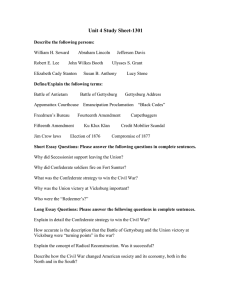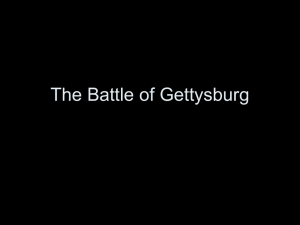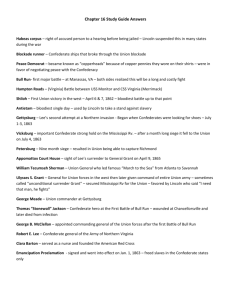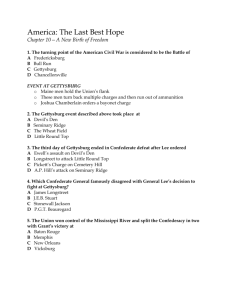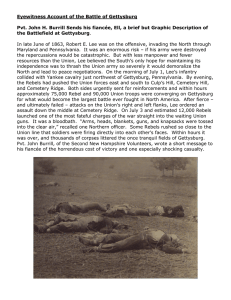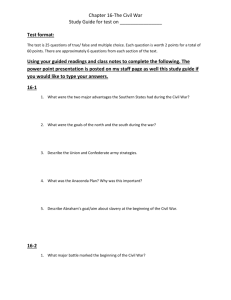gettysburg - National Park Service History
advertisement
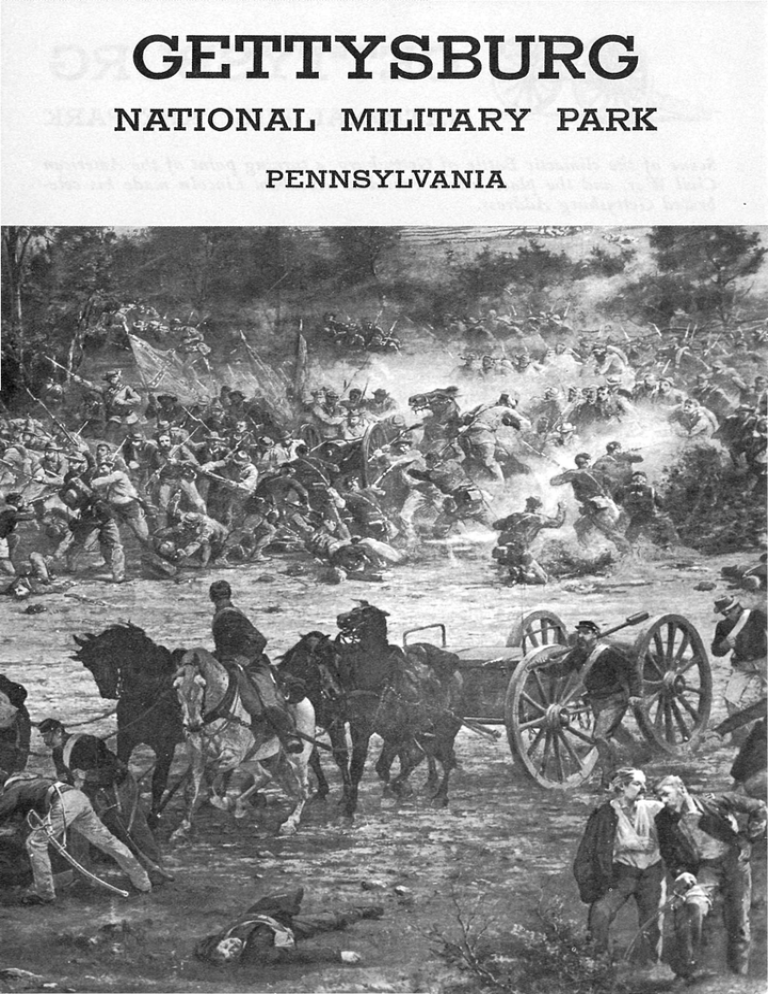
GETTYSBURG NATIONAL MILITARY PARK PENNSYLVANIA GETTYSBURG NATIONAL MILITARY PARK Scene of the climactic Battle of Gettysburg, Civil War, and the place where President brated Gettysburg Address. Of the more than 2,000 land engagements of the Civil War, Gettysburg ranks supreme. Though Gettysburg did not end the war, nor attain any major war aim for North or South, it remains the great battle of the war. Here at Gettysburg on July 1, 2, and 3, 1863, more men died than in any other battle fought before or since on North American soil. Here the Confederacy saw its greatest offensive turned back, saw its splendid army retreat to Virginia with no gain to match its valor and terrible sacrifices. Here for the first time in the war, the men in the Union Army of the Potomac rose up from their lines after the battle and cheered, aware that they had repulsed the hardest hammering that Robert E. Lee's Army of Northern Virginia could give them. Here—4 months later—President Lincoln summed up the meaning of the war, using 269 words that surpass the millions uttered and written since. THE NORTH INVADED General Lee had led his men north of the Potomac River once before—in September 1862. He had hoped that a successful campaign on Northern soil might win foreign recognition for the Confederacy and lead to a negotiated peace. But the Battle of Antietam halted this invasion, and the war had continued. a turning point of the Abraham Lincoln made American his cele- Great Southern victories had since been won at Fredericksburg and Chancellorsville in Virginia. In the west, however, Union armies were probing deep into the Confederacy. The Southern stronghold at Vicksburg—key to control of the Mississippi River—was besieged. If Lee's veterans now launched another offensive across the Potomac, they might relieve the pressure on Vicksburg; they might even win a decisive victory that would bring peace and independence to the South. Out of such hopes was born the Gettysburg Campaign. The Army of Northern Virginia began its march on June 3. From Fredericksburg, where they had shielded Richmond from the Army of the Potomac, the long columns headed west through the gaps of the Blue Ridge, then northeast to Pennsylvania in the sheltered slot of the Shenandoah and Cumberland Valleys. When Union Gen. Joseph Hooker saw the thin ranks Lee had left behind to screen Richmond, he wanted to strike for the Confederate Capital. But President Lincoln directed him to pursue Lee's army, keeping between the Southern host and Washington. During Lee's northward march, his main body of cavalry under Gen. J. E. B. Stuart had swung to the east. Union forces in close pursuit cut Stuart off, depriving Lee of the "eyes" of his army. Lacking Stuart's reports, The National Park System, of which this park is a unit, is dedicated to conserving the scenic, scientific, and historic heritage of the United States for the benefit and inspiration of its people. Lee did not know until June 28 that the Union army—now commanded by Gen. George G. Meade—was following him. Then, realizing that a battle was imminent, Lee ordered his scattered forces to concentrate at Cashtown, 8 miles west of Gettysburg. Two days later, on June 30, Gen. John Buford's Union cavalry contacted a Confederate detachment near Gettysburg, then occupied McPherson Ridge, just west of the town. Thus, groping through the fog of war, the fingertips of the vast armies had chanced to touch at Gettysburg. Now began the race to concentrate winning power. THE BATTLE BEGINS Early on July 1, Buford's pickets opened fire on the Confederate vanguard approaching from Cashtown. Soon the Union cavalry was reinforced by Gen. John F. Reynolds' infantry. Meanwhile, jamming the roads which converged like spokes on the hub of Gettysburg, dusty columns of both armies pounded toward the sound of the guns. Until 1 p.m., the Union troops on McPherson Ridge held the attacking Confederates at bay. But suddenly the hills and ridges north of town came alive with charging men. In a concerted attack from west and north the powerful Confederate forces smashed into the Union lines. Back through the town fled the men in blue. Many units fought heroic rearguard actions to protect their retreating comrades. By 5:30 p.m., the Union remnants were hurriedly entrenching south of Gettysburg on Cemetery Hill, where Gen. Winfield Scott Hancock—a rock in adversity—rallied their shattered ranks. At the sound of the cannonade, General Lee had hastened to the front. He watched the Federals stream toward the hills south of town and begin their entrenchments. Though aware that their position was a strong one, he believed it could be crushed by attacking Culp's Hill or Cemetery Ridge, the southerly extension of Cemetery Hill. THE SECOND DAY By dawn, July 2, Lee's army was poised before the hook-shaped Union line; he hoped to break it before Meade's entire force reached the field. His plan of attack called for Gen. James Longstreet to assault the Union left on Cemetery Ridge. To aid the main attack, Gen. Richard Ewell's men would advance on Cemetery and Culp's Hills, at the right of the Union line. Action on July 2. Longstreet's Confederates charge across the Wheatfield. Reproduced from an original glass-plate negative at Gettysburg National Military Park. Original painting by James E. Taylor, 1885. Delay dogged Confederate preparations, and the morning wore away; with it went Lee's hopes for an early attack. Just after noon, Union Gen. Daniel Sickles pushed his troops westward from Cemetery Ridge. His new line formed a salient with its apex at the Peach Orchard on the Emmitsburg Road. This powerful intrusion further complicated Lee's attack plan. Finally, at 4 p.m., Longstreet's batteries broke the silence. Gen. John B. Hood's division struck the Union flank at the Round Tops, Devil's Den, and the Wheatfield; close on his left, Lafayette McLaws' men charged the Union salient at the Peach Orchard. Farther north, R. H. Anderson's division struck the Emmitsburg Road. By sundown, the Confederates had completely shattered the Union salient. But to the north, Ewell's attack on Cemetery and Culp's Hills had bogged down. Though individual units had been desperately brave, the attack failed for lack of coordination. Spangler's Spring and the Union defense works just north of it were captured after dark, but the main Union line stood unbroken. Except for the isolated struggle to the north, darkness ended the fighting and blotted from view the corpses that signified the day's work. But wounded men continued their pitiful calls for aid through the night. Though partially successful, Lee had lost the race to win a decisive victory while still holding the advantage of numbers. Throughout July 2, fresh infantry had filed into Meade's line and new batteries had wheeled into place. Facing Lee now, in a position growing ever stronger, was the entire Army of the Potomac. LEE'S FINAL EFFORT July 3 broke with the thunder of Union guns near Spangler's Spring and Culp's Hill. After a furious struggle, the Federals recaptured the spring, erasing the threat to their right flank. Meanwhile, Lee decided that further attacks against the strong Federal flanks were not feasible. To retain the initiative he de- cided upon a massive frontal assault against Meade's center. A breakthrough there would cut the Federal army in half and might open the way to that decisive victory the Confederacy needed. His fighting blood up, Lee waved aside Longstreet's objections to a frontal assault against the strong Union line. Pointing to Cemetery Ridge, he exclaimed: "The enemy is there, and I am going to strike him." Now Lee massed his forces along and in front of Seminary Ridge. J. E. B. Stuart— finally back with the army—began moving his cavalry to a point where he might harass the rear of the Federal army. (This design was thwarted when alert Union cavalry intercepted Stuart.) Meanwhile, the Federal troops of General Hancock's Corps eyed the Confederate line from behind the stone wall that marked their position on Cemetery Ridge. Near an angle in the wall, an umbrella-shaped copse of trees provided shade for some of the men. These lucky ones might have preferred hot sun elsewhere had they known that the anticipated Confederate attack was to be aimed directly at these trees. At noon, stillness descended over the battlefield. Men waited in their positions, and the heat grew more intense. Suddenly, at 1 o'clock, 140 Confederate guns in line from the Peach Orchard to the seminary let loose an earth-shaking cannonade. Its objective: To prepare the way for the infantry assault against the Union line on Cemetery Ridge. Federal artillery responded with counterbattery fire, and for a time the massed guns dueled for supremacy. Finally, nearly 2 hours later, the cannonade died away. Then, reluctant with foreboding, the commander of the assault column, General Longstreet, ordered the advance. With Gen. George Pickett's division on the right and those of James Pettigrew and Isaac Trimble on the left, nearly 15,000 Confederates moved forward in magnificent array. Union defenders were stunned at sight of the milewide column with its scores of regimental flags. Gettysburg Address Memorial, Gettysburg National Cemetery. Marching in dressed ranks across the open fields, battered by Union artillery most of the way, the attackers now converged upon Meade's center. Momentarily the long lines were slowed by the rail fence at the Emmitsburg Road, then they rushed up the slope of Cemetery Ridge toward the line of fire erupting from the stone wall. From front and flank, double canister and rifle volleys assailed the charging lines. They crumbled, re-formed, and again pressed forward. Only 150 men led by Gen. Lewis Armistead crossed the stone wall, there to be overcome after savage hand-to-hand fighting. Meanwhile, Federal regiments to the right and to the left of The Angle wheeled in front of the stone wall and delivered a raking fire into the blunted wedge of Confederate attackers. Then came a Union countercharge that swept the staggering Confederates off Cemetery Ridge—those that could walk. Thousands of dead and wounded remained behind. The remnants of the great charge sullenly retreated toward the shelter of their guns. There General Lee greeted them, told them to re-form, to rest, to prepare defenses against a possible Federal counterattack. Lee's supreme effort had failed. The Copse of Trees on Cemetery Ridge became the High Water Mark where the tide of the Confederacy had "swept to its crest, paused and receded." It was all over at Gettysburg. Lee's heavy losses precluded further effort by him on this field. And Meade did not reopen the battle. Late on the afternoon of July 4, Lee began an orderly retreat southwest over the Hagerstown Road and through the mountain pass. Followed cautiously by Meade, Lee crossed the Potomac safely into Virginia on the night of July 13. The Army of Northern Virginia had escaped, but it had been so cruelly mauled that never again would it invade the North. AFTERMATH In the battle, 75,000 Confederates had been pitted against 97,000 Union troops. Lee lost 28,000 killed, wounded, and captured as against a Union loss of 23,000. For the townspeople, the aftermath of battle was more trying than the battle itself. Wounded men were crowded into almost every building. Dead men littered the countryside. Soon after the battle, Gov. Andrew Curtin of Pennsylvania commissioned Attorney David Wills of Gettysburg to purchase a burial ground for the Union dead. (Confederate dead originally buried on the battlefield were reinterred in Southern cemeteries.) While reinterment from the temporary battlefield graves was still in progress, the formal dedication took place on November 19. On that occasion President Lincoln delivered his Gettysburg Address. THE PARK In 1895, the Gettysburg battlefield was made a National Military Park by act of Congress. In that year the Gettysburg Battlefield Memorial Association, which was founded a few months after the battle, transferred its holdings to the Federal Government. Today the battlefield has 30 miles of paved avenues and 1,425 monuments and markers. The area of the National Military Park is more than 2,800 acres. The National Cemetery covers 17 acres. 50-cent admission fee is waived for children under 12 and school groups. Licensed guides provide complete 2-hour tours, $5; 1-hour tour to major points of interest, $ 3 ; and complete bus tours, $8. ABOUT YOUR VISIT The National Park Service MISSION 66 program at Gettysburg National Military Park is providing many new visitor facilities, including the new Park Visitor Center. Just south of town on either U.S. 15 or State Route 134, the visitor center is open every day except Christmas and New Year's. Here you can see free exhibits and get information before touring the battlefield. Also on exhibit here is the notable painting of Pickett's Charge, "The Gettysburg Cyclorama"—a Gettysburg National Military Park and Cemetery are administered by the National Park Service, U.S. Department of the Interior. A superintendent, whose address is Gettysburg, Pa., is in immediate charge. ADMINISTRATION Help Protect this Park: Speed limit 25 m.p.h.—15 m.p.h. in crowded areas; park only on pavement to protect grass and shoulders; no climbing on monuments and cannons; preserve all natural features. Please report all accidents and fires to the nearest park ranger. EXPLORING THE BATTLEFIELD Many opportunities await those who want to tour the battlefield at their own pace. A 1-hour walking tour, starting at the visitor center, leads to Meade's Headquarters, The Angle, the High Water Mark Monument, and the National Cemetery. A 2- to 3-hour auto tour covering the entire park starts from the visitor center parking area. The text and map that follow describe this tour. 1. High Water Mark. Here, at the Copse of Trees and The Angle, Longstreet's Assault, or Pickett's Charge, was halted on July 3. This was the climax at Gettysburg. 2. Pennsylvania Memorial. On a field noted for its monuments, this one is outstanding. Statues of officers and bronze nameplates call the roll of nearly 35,000 Pennsylvanians who fought here. 3. Little Round Top. Longstreet's attack on July 2 foundered on the rocky slopes of this hill. Quick action by Meade's chief engineer, Gen. Gouverneur Warren, saved Little Round Top for the Union army and foiled Lee's hopes for early victory. 4. Devil's Den. Longstreet's July 2 attack cleared Union troops from these boulders. Confederate sharpshooters, one of whose barricades can still be seen, fired on Little Round Top from here. 5. Peach Orchard. On July 2, General Sickles' Union salient extended from Devil's Den to here, then angled northward on the Emmitsburg Road. Longstreet's attack shattered this Union line. 6. Warfield Ridge. Here, at 4 p.m., July 2, Longstreet's guns opened fire on the Peach Orchard. At this signal, infantry massed on this ridge swept forward against Sickles' salient. 7. Virginia Monument. General Lee watched the gallant charge of July 3 from here. And when it failed, he rode forward to the fields in front of you and rallied his men. curve, turn left on Stratton Street. Continue to York Street then left one block to Liberty Street. Turn right on Liberty Street, which becomes East Confederate Avenue and takes you to Spangler's Spring. 8. North Carolina Monument. Along and in front of this ridge, Lee marshaled his forces for the supreme effort on July 3. The monument was sculptured by Gutzon Borglum of Mount Rushmore fame. 13. Spangler's Spring. On July 2, Ewell's Corps attacked in this vicinity. Gen. Edward Johnson's division captured this spring and Union earthworks north of it, only to lose them the next morning. 9. McPherson Ridge. Just beyond McPherson's Barn, the Battle of Gettysburg began at 8 a.m. on July 1. General Reynolds, whose Union infantry held this line, was killed in the woods to the left. 14. Culp's Hill. On July 2, Johnson's Confederates attacked here without success, but captured Spangler's Spring to the south. 10. Oak Hill. Arrival of General Rodes' Confederate division on this hill at 1 p.m. on July 1 threatened Lederal forces west and north of Gettysburg. The Eternal Light Peace Memorial, dedicated in 1938, commemorates the 75th anniversary of the battle. 11. Oak Ridge. Union troops here held stubbornly against Rodes' advance from Oak Hill. 12. Barlow Knoll. When Jubal Early's Confederates smashed Union defenders here at 2:30 p.m. on July 1, the Union line north of Gettysburg collapsed. From Barlow Knoll, take U.S. 13 to the point where it curves right. Just pass the GETTYSBURG GETTYSBURG NATIONAL MILITARY PARK PENNSYLVANIA PENNSYLVANIA 15. East Cemetery Hill. Here Union troops rallied late on July 1. The next evening the hill was captured and briefly held by Early's Confederates. Note the Civil War-period gateway to the town Cemetery across the Baltimore Pike. 16. National Cemetery. Soldiers' National Monument, commemorating Union dead who fell here, stands on the spot where President Lincoln delivered his Gettysburg Address. The Gettysburg Address Memorial is near the west entrance. This concludes the auto tour except for the important site at East Cavalry Field, 3 miles east of Gettysburg on State Route 116. Here Union cavalry under Gen. D. M. Gregg intercepted and defeated J. E. B. Stuart. U N I T E D STATES DEPARTMENT OF THE INTERIOR NATIONAL PARK SERVICE NATIONAL MILITARY PARK Cover: Climax at The Angle. This scene from Paul Philippoteaux' Cyclorama shows the Confederate vanguard piercing the Union line on Cemetery Ridge. Reprint 1963 U.S. GOVERNMENT PRINTING OFFICE: 1963—O-681820
